Jingmai Tea Mountain in Puer-UNESCO World Cultural Heritage

Chinese Name:普洱景迈山古茶园
English Name: Jingmai Tea Mountain in Lancang County, Puer
Chinese Pinying: Jingmai Gu Cha Yuan
Keywords: Puer Tea, Ancient Tea Tree
Location: Located in Huimin Township, Lancang Lahu Autonomous County, Pu'er
Admission Fee: Free
Opening hours: All day
Best Time To Visit: All year
Where is Jingmai Tea Mountain
Why is Jingmai Tea Mountain so special?
In Yunnan, likely the most culturally diverse province of China, Jing Mai Mountain and its’ wild forest of ancient tea trees is located at the southern tip of the province, equidistant from Laos, Burma and Vietnam. This forest is a national treasure made of trees 1,000 years old. The Bulang and Dai hill tribes have enjoyed the area’s teas for more than 1,300 years.
This is one of the world’s tea treasures as it is one of the most well preserved large wild organic tea plantations. The forest is situated at about 5,000 feet above sea level and contains ancient tea trees spanning heights of up to 50 feet. Enshrouded in mist through the year, the Ancient Organic Tea Plantation has continued to flourish from the time of the beginning of the Chinese Sung Dynasty or European Middle Ages to the present due in part to the area’s fertile soil, good climate, lack of pollutants and remoteness from modern cities. Although the plantation contains an area of about 32,000 acres, the actual area that is harvested for tea amounts to roughly 10,000 acres.
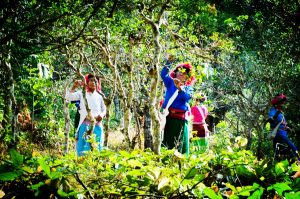
The leaves from the tea trees bud early in the year. The particular jat of these tea trees is called Yunnan Da Yeh or Yunnan Broad Leaf and, being wild, it is unspoiled by machine or chemical cultivation. The leaves are soft and thick, revealing a special white hair-like tip. There are well over one hundred varieties of teas produced from the trees of this plantation, hand cultivated in small lots to ensure sustainability.
Preservation of this tea forest is a priority and continues to be funded through eco-tourism and Fair Trade support. Additionally all of the teas are OCIA, NOP, JAS and EU Organic certified. The Jing Mai Manling Ancient Tea Association is made up of members of the various tribes, growers and producers of the area, and is certified FLO/Fair Trade by TransFair USA.
What to see in Jingmai Tea Mountain
The region of Hengduan Mountains of Yunnan in China, is a world’s biodiversity hot spot and place of origin and reservation for various species. In recent years, wild ancient tea trees of some 2700 years old, half wild-half cultivated ancient tea trees older than 1000 years and well preserved large ancient Pu’er tea plantations with tea trees of 100-1000 years old have been discovered in this area, making it one of the regions that practiced earliest use of tea resource and had significant influence on the tea culture of the world.
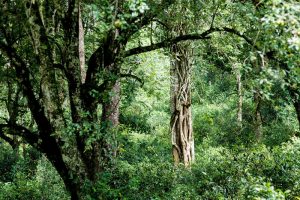
The nominated property is located on the Jingmai Mountain in the southwestern border area of Yunnan Province, with widely distributed tea plantations. The Mountain has a declining trend from the northwest to the southeast. In about 180 A.D., a branch of Blang, an ethnic minority group, discovered tea when migrating to the region of Jingmai, and tried to cultivate tea trees in the forest because of limited land and the climate and soil conditions favorable for tea trees. In the 3rd century, Blang people gradually mastered the tea cultivation techniques, and began to domesticate, cultivate tea trees and trade tea products, thus started the 1800 years’ history of tea cultivation, settlement and development in this area and passed on from generation to generation. According to historical records, the earliest recorded tea market in the nominated area came out in 1139 A.D., and the tea trade flourished in the Qing Dynasty.
In the nominated area, the highest elevation reaches 1662 meters (Nuogang Mountain) and the lowest 1100 meters (Nanlang Valley). Ancient tea plantations are mainly distributed in the mountain area of 1250-1550 meters above sea, and concentrates in three areas: Manggeng-Mengben ancient tea plantations, Jingmai Dapingzhang-Nuogang ancient tea plantations and Mangjing ancient tea plantations. In a total area of 1870 hectares, there are about 1.13 million ancient tea trees, of which the oldest tea tree has a history of 1400 years. Less than 10% of the tea trees are aged500-1000 years, about 30% are 300-499 years old, and the average age of the tea trees in the entire biocenosis is about 200 years. The nominated area is not only the largest and the best-preserved ancient tea plantation area of the region, but also the largest ancient cultivated arbor tea plantation of the world.
Ancient tea trees grow extensively in secondary growth tropical monsoon evergreen broad-leafed forests in South Asia. Such forests have the arbor layer at the top, the shrub layer in the middle and the vegetation layer at the bottom. Tall arbors such as toona ciliata and ficus microcarpa grow in the upper layer; the middle layer is dominated byancient tea trees and decorated with lauraceae, ericaceae and other plants; and the lower layer is covered by gramineae and herbs such as ferns, galenicals and wild vegetables. Compared with common terraced tea plantations, such a special multi-layered ecosystem helps ancient Pu’er tea plantations with well-preserved soil fertility and effectively reduced disease and pest. The special way of tea cultivation in forests was created by human through persistent study of the nature.
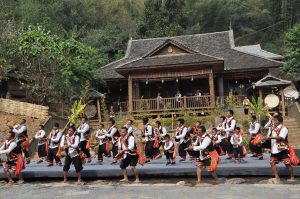
Over more than one thousand years, native people have built a close and friendly interaction with the ancient tea plantations based on discovery, cultivation and utilization of tea, thus forming a charming mountain settlement landscape and rich regional ethnic culture. The nominated property involves two administrative villages, namely Jingmai and Mangjing, with a total population of about 5,500 from more than 1500 households, respectively belonging to the Dai, Blang, Hani and Wa nationalities. In this region there are eight minority villages with distinctive characteristics generally built in area about 1500 meters above sea with sufficient sunlight, surrounded by forest, farmland, wild tea trees and wild animals. The villages have clear public centers-village heart. Residential houses are mainly two-storied pile-dwellings with a balcony for drying tea. Symbols of tea are often used on buildings as decorative patterns. Rich folk cultures are derived from tea production process, including religion, language, customs, architecture culture, vernacular literature, village regulations and so on. In particular, local people not only believe in Buddhism, but also believe in the “tea ancestor”. A grand ritual will be held each year for their ancestors who discovered tea, and in each tea plantation, a most exuberant tea tree will be worshiped and respected as a “tree of tea spirit”. A series of village regulations are formulated and played an active role in protection of the ancient tea plantations. Therefore, the nominated area is the most typical place reflecting harmonious relationship between human and land.
Justification of Outstanding Universal Value
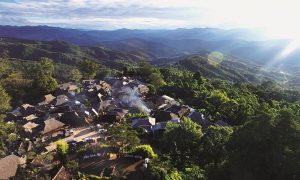
The Ancient Tea Plantations of Jingmai Mountain is a special cultural landscape with the thousand-years-old domesticated-cultivated ancient tea plantations as the core, including elements such as forest ecosystem closely related to the growth of ancient tea trees, native ethnic villages and rich folk cultures. It has great vitality even today.
The nominated area, which is the largest ancient artificially cultivated tea plantation in the world, witnesses the complete evolution of tea from wild growth to artificial domestication as an important life and culture resource of human being. Tea was also brought to every corner of the world through some important regions and international channels and made important contributions to the world’s tea culture and the development of civilization.
The nominated area, on the basis of the belief in “animism”, created unique techniques for artificial cultivation of tea trees under forest system, a technology of land use adapted to natural condition on different altitudes, and a town and village construction technology in harmony with the environment and the tea culture, thus forming an unique mountain landscape integrating “human, land, tea, forest”. It is a typical example of the harmonious relationship between man and nature showing the great wisdom of human to know, to respect and to use the nature.
Native minorities live here in harmony and develop the tea culture of the region, which shows integration of the national culture based on the common value of “tea”. The protection and management rules formulated and executed by local people created the ethnic religion and tradition closely related to tea culture, had profound influence on the development and transmission of tea culture, and serve as indispensable intangible heritage demonstrating the development of tea culture and the graceful vision of harmonious interpersonal coexistence.
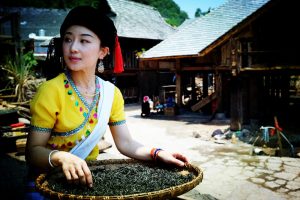
Therefore, the nominated area is an outstanding example of the agricultural landscape. It embodies ecological ethics of harmonious coexistence between people and between human and nature which have important outstanding universal value for common prosperity and development of the world in modern times.
Criterion (iii): Since 1800 years ago, Jingmai people discovered and domesticated tea, and based on their respect to the nature, formed a millennium sustainable ancient tea garden landscape known as “living tea tree museum”, which is a microcosm of the development of Chinese tea culture and civilization, an outstanding representative of the world’s tea culture, and a model of coexistence between man and nature. As one of the birthplaces of the world’s tea culture, Jingmai Mountain is a part of the Ancient Tea-Horse Route, through which tea culture spread all over the world and made great contribution to the development of the tea culture and civilization. It is a historical testimony of the important contribution of the Chinese nation to the industrial development of tea , one of the major beverages of the world.
Criterion (iv): The Ancient Tea Plantations of Jingmai Mountain, integrating natural forest, the ancient tea garden landscape, modern terrace tea landscape and coexistence of traditional residential villages and natural mountains, is an outstanding representative of agricultural landscape of dryland terrace tea culture. People of various nations live in traditional villages in harmony for generations together with development of tea mountains, reflecting the common value and social cohesion based on tea culture and having significant influence on the local village planning still today. In the preserved traditional residential buildings, the religion systems and traditional customs of the ethnic minorities are integrated into the village planning and architectural design, the tea culture is blended with ethnic faith and daily culture, and tea is symbolized and mixed into architectural design and ethnic costumes and culture, reflecting local distinctive features of local tradition and tea culture. Ancient tea gardens which exist for thousand years, as well as the mountain residential buildings and traditional culture highly mixed with tea culture and local natural environment witness the evolution of the regional civilization and culture based on tea industry, reflect the achievements of tea culture combining both material and spiritual civilization, highlight the example of coexistence between human and the nature that reaches an ideal state of natural harmony, man-nature harmony and ethnic harmony.
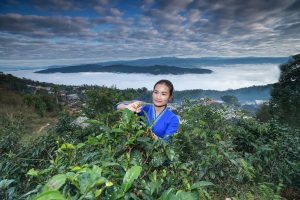
Criterion (v): Based on specific natural conditions of the primitive forest and the cultural background of “animism” belief, the Ancient Tea Plantations of Jingmai Mountain, with its historical ancient tea culture and the ecological value of harmony between man and nature, form an ancient tea garden ecosystem which is on the basis of respecting natural resource and sustainable development. Under extreme conditions of mountains, local residents strictly protect primitive forest, forming a unique vertical land-use pattern, create a technology of planting tea in forest, develop unique ancient artificial tea forests in natural forests, and form a local tea culture landscape of Jingmai style. The coexistence of forest and tea garden, as well as the rules formulated to protect the landscape and ancient tea garden, set an outstanding example of land use, and reflect the ecological ethics of respecting nature and harmony between man and nature, and have important inspiration for the development of world ecological civilization.
Statements of authenticity and/or integrity
Authenticity
The elements of the cultural landscape are authentic. Both the ancient tea plantations and ethnic villages are preserved with the historical atmosphere. The three ancient tea plantations are well-preserved; the largest population in villages is still ethnic minorities; more than 90% residential houses are traditional. Moreover, traditional custom and cultural tradition are still observed by local people, most labors are engaged in maintenance of tea plantations, tea is their main source of income. Ancient tea domestication techniques and traditional ancient tea plantation techniques remain intact; lands are used in original modes; and conservation management system of ancient tea plantations is inherited and carried forward.
The general structure of the cultural landscape is also authentic. Both the human-land-tea plantation-forest composition and the vertical land use mode are preserved with authenticity. Therefore, a high degree of authenticity is kept in the nominated area in terms of material, design, technique and function.
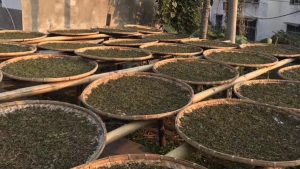
Integrity
Landscape elements supporting the value of the nominated area are integral. Within the proposed boundary, the landscape contains all necessary elements reflecting the outstanding universal value of the tea cultural landscape throughout its evolution. Four elements, namely domesticated and cultivated ancient tea trees, natural forest closely related to growth of ancient tea trees, minorities such as Blang as users and defenders of ancient tea trees, and their villages, are well preserved in terms of their composition and function, and are interdependent to reflect the historical characteristics of the ancient tea culture in the region which have been passed down till today. Regional scope supporting the value of the nominated area is integral. The nominated areas of the ancient tea plantations are sufficiently large to exhibit the value content of the cultural landscape of tea industry. The nominated area includes 16,000 hectares of cultivated ancient tea plantations with about 1.13 million ancient tea trees. It is the largest one of the 14 major Pu’er ancient tea mountains, including all elements to exhibit the tea culture landscape. Besides, there are about 23,000 hectares of terrace tea plantations, about 34.5 million tea trees, approximately 69,000 hectares of symbiotic woodland in original state, eight villages, and four native ethnic groups of Blang, Dai, Hani and Wa.
As the major source of life for local people, the landscape plays a role in the tea business, and is preserved according to strict standards. A series of protective regulations are formulated by the local government, and some regulations are spontaneously formed by local people to conserve the integrity of the landscape, making its core landscape well-preserved.
Comparison with other similar properties
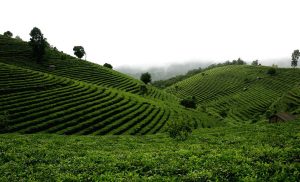
There are 18 World Heritage properties related to agricultural landscape in the World Heritage List, including 6 of beverage plants, 2 related to coffee and 4 related to grape wine. At present, there is not a cultural landscape World Heritage focusing on tea cultivation and tea culture. Tea as one the three major beverages of the world is an important agricultural heritage with outstanding universal value. Tea culture-based agricultural landscape is a combination of material and spiritual cultures.
Cultural landscapes of different agricultural products present themselves in different ways. In the region of the Jingmai Mountain, the landscape formed by the close tie between man, tea trees and land is an outstanding example of harmonious coexistence of man and nature, reflecting the integration of local people and natural landscape, which is well preserved even today. The cultural landscape formed by cultivation of tea trees is not only a representative of local culture but of traditional Chinese tea culture. It represents regional features and national culture. Chinese tea culture integrates Chinese Buddhism, Confucianism and Taoism, and connects nature and man, functioning as an important medium for human communication and cultural exchange. Tea, spread from China to the world, makes important contributions to the world’s culture. Different from other heritages represented by agricultural technology or regional cultures, the national culture embodied in tea plantation landscape is of the essential significance.
The famous Assam tea plantation in India, tea plantations in Sri Lanka, Shizuoka tea plantation in Japan, etc. are mainly terrace tea landscapes with standardized modern cultivation. They are professionally managed by limited corporations with large scale. While the Ancient Tea Plantations of Jingmai Mountain are cultural landscapes formed by adaptation to the nature under extreme conditions. The local people discovered, domesticated and cultivated tea to form a traditional way of ancient tea cultivation in natural forests which is still in use today, thus creating a sustainable ecological system and land use mode. The traditional protection by local people helps tea plantations of Jingmai mountain remain their vitality and free of damage in thousand years’ evolution. The landscape with coexistence of land and man has rich cultural significance in world’s dryland terrace tea culture, reveals the law of association between man and land, development and protection, achieves the state of natural harmony, harmony between man and nature and harmony between ethnic groups, and stands as an outstanding example of mutual growth of nature and mankind.
Cultural Landscape of Old Tea Forests of the Jingmai Mountain in Pu’er
Location:
Jingmai Mountain, Huimin Town, Pu’er City, Yunnan Province, Southwestern China.
Overview:
The Cultural Landscape of Old Tea Forests of the Jingmai Mountain in Pu’er is a historically significant tea production area developed over a thousand years by the Blang and Dai peoples. This landscape includes traditional villages, old tea groves, and tea plantations surrounded by forests. The traditional understorey cultivation of old tea trees responds to the mountain’s ecosystem and subtropical monsoon climate. Local Indigenous communities maintain a governance system that supports these practices, which are deeply rooted in the cultural belief in Tea Ancestor spirits that reside in the tea plantations and local fauna and flora.
Outstanding Universal Value
Brief Synthesis:
This cultural landscape is a testament to the ancient tea cultivation traditions of the Blang and Dai peoples, dating back to the 10th century. The traditional land-use system on Jingmai Mountain includes tea groves, tea plantations, forests, and traditional villages. The practices and governance system are designed to work in harmony with the mountain’s unique ecosystem and subtropical monsoon climate. Traditional ceremonies and festivities centered around the Tea Ancestor belief play a key role in preserving this cultural heritage.
Criteria for World Heritage Status
Criterion (iii): Exceptional Testimony of Tea Cultivation Traditions
The Cultural Landscape of Old Tea Forests of the Jingmai Mountain in Pu’er exemplifies the understorey tea cultivation traditions that have supported the sustainable use of natural resources for over a thousand years. The Blang and Dai peoples have maintained a tripartite social governance system (tribe-government-religion) that has preserved the old tea forests and safeguarded cultural and biological diversity through careful consideration of the mountain’s climate, topography, and local flora and fauna.
Criterion (v): Sustainable Land-Use System
This landscape represents an outstanding example of a sustainable land-use system, with a combination of horizontal and vertical land-use patterns. These patterns allow for the complementary use of natural resources in the mountainous environment, showcasing the harmonious interaction between the Blang and Dai peoples and the challenging environment of Jingmai Mountain. The traditional villages’ layout and residential buildings reflect the unique cultures and traditional knowledge of these Indigenous communities.
Integrity
Preservation of Social and Ecological Interdependencies:
The integrity of the property is based on the preservation of the social relationships and ecological interdependencies among the climate, topographic features, and cultural practices of the Blang and Dai peoples. The boundaries of the property include all key attributes, such as the old tea forests, protective partition forests, tea plantations, traditional villages, and cultural practices related to tea cultivation, including festivals, religious ceremonies, and traditional dances.
Current Challenges:
Traditional villages within the property face pressure from urban development, which could be exacerbated by increased tourism. These factors pose potential threats to the integrity of the cultural landscape.
Authenticity
Continuity of Traditions:
The authenticity of the property is rooted in the continuity of its traditional practices, including the location, use, and function of the old tea forests; the design and function of traditional villages and houses; and the land-use system. The authenticity is further supported by the continuous upkeep of cultural practices, legends, oral history, traditional knowledge, and the belief and governance systems associated with tea culture on Jingmai Mountain.
Protection and Management Requirements
Legal Protection:
The property is protected under national laws governing cultural heritage, ecology, environment, forests, and intangible cultural heritage. Local authorities have also implemented specific laws and regulations to ensure its protection. A buffer zone around the property provides additional protection, with regulated development in surrounding forests, farms, and villages.
Management System:
A comprehensive protection and management system has been established, involving all stakeholders, including local authorities, villagers, and professional institutions. This system is supported by a tribe-government-religion governance structure and detailed planning documents, such as the Conservation Plan for the Cultural Heritage of Old Tea Plantations of Jingmai Mountain (2017-2035) and the Conservation Management Plan for the Cultural Landscape of Old Tea Forests of Jingmai Mountain (2020-2040). Regular monitoring and a disaster preparedness mechanism ensure the ongoing conservation and sustainable development of the property.
Jingmai Tea Mountain Travel Guide:
I. Recommended Travel Route:
Lancang County Town → Huimin Town → Manggen → Jingmai Dazhai → Dapingzhang Ancient Tea Forest → Nuogan Ancient Village → Mangjing → Wengji Ancient Village
II. Jingmai Mountain Must-Visit Tourist Spots:
1. World Heritage Exhibition Halls The heritage exhibition consists of one center, two exhibition halls, and two exhibition rooms, located in Huimin Town, Jingmai Dazhai, Lower Mangjing, Wengji, and Nuogan. At the Jingmai Mountain Exhibition Center in Huimin Town, you can gain a comprehensive understanding of the geographic location, flora and fauna, village distribution, and ethnic culture of the Jingmai Mountain Heritage Area. You can also learn about the three key elements of the ancient tea forest cultural landscape’s World Heritage application and watch the Jingmai heritage short film.
2. Manggen Manggen is the first village you encounter upon entering Jingmai Mountain from Huimin Town. It maintains the traditional layout of a Dai ethnic village, centered around the village heart and developed in a radial pattern. Near the village heart, you’ll find the Manggen Buddhist Temple, a site for religious activities and major festivals. The village heart, temple, Sadi Well, Sadi Tomb, sacred tree, and Golden Pond are all heritage sites that contribute to Manggen’s traditional village value, making them must-visit spots.
3. Jingmai Dazhai Jingmai Dazhai is considered the first settlement of the Dai people when they migrated to Jingmai Mountain. Legend has it that Dai ancestor Zhao Nuo La led his followers in pursuit of a deer to Jingmai Mountain and settled there, naming the place “Jingmai,” meaning “new town.” Jingmai Dazhai has preserved the traditional layout of a Dai village, with the temple and village heart at its center, radiating outward. Here, you can visit the Golden Pagoda to see the sea of clouds, explore ancient Dai villages, visit local homes, taste thousand-year-old tea, tour the village exhibition hall, and sample tea from various households.
4. Dapingzhang Ancient Tea Forest Located in the core area of the Jingmai Mountain Heritage Site, Dapingzhang Ancient Tea Forest has a history of over a thousand years. As you walk into the forest, towering trees provide shade and coolness. Beneath these trees grow ancient tea trees, green and robust, with “crab’s claw” plants and various epiphytes thriving on them. Butterflies dance among the flowers blooming around the tea trees, and the occasional sound of bells can be heard as villagers’ yellow cattle wander through the forest, creating a picturesque ecological scene.
5. Nuogan Ancient Village Nuogan is a Dai ethnic village located at an altitude of 1,450 meters. It is the most distinctive and well-preserved Dai traditional village landscape within the Jingmai Mountain Heritage Area. “Nuogan” is a transliteration from the Dai language, where “Nuo” means pond and “Gan” means deer, signifying “the place where deer drink water.” The village is a peaceful place where residents in traditional Dai clothing can often be seen sorting tea leaves in front of their old houses, seemingly untouched by the fast-changing world outside.
6. Mangjing Mangjing is located in the heart of the thousand-year-old ancient tea garden, known as the “Tea Culture History Museum.” The area includes ten thousand mu (hectares) of ancient tea gardens, the King Bee Tree, Aileng Mountain, the Tea Soul Terrace, and the Princess Banyan Tree, among other attractions. The King Bee Tree, located northeast of Upper Mangjing Village, is about 50 meters tall, with dozens of beehives built on its branches, making for a spectacular sight. The Brown ethnic group in Mangjing protects this sacred tree and holds a “Bee Summoning” ceremony under it during major festivals. The Princess Banyan Tree, located at the junction of Upper and Lower Mangjing Villages, is also worth seeing, as it straddles both sides of the road, with its legend tied to the burial site of the seventh princess of the Dai king.
7. Wengji Ancient Village Wengji is a traditional Brown ethnic village, also known as the “Thousand-Year Brown Ancient Village,” situated at an altitude of 1,700 meters. The village has preserved the traditional layout and historical appearance of a Brown ethnic village on Jingmai Mountain. The village buildings are arranged along contour lines around the village heart, with traditional stilted houses facing the village center. Must-see spots include the temple, village heart, ancient cypress trees, as well as the tea rooms, ethnic clothing shops, and quaint buildings scattered throughout the village. Strolling through the village, sipping tea, and enjoying the scenery is a perfect way to spend a leisurely time.
III. Experiential Activities:
- Dai paper-making experience
- Traditional Brown roasted tea
- Traditional tea-making techniques of Jingmai Mountain
- Ethnic costume rentals
IV. Accommodation Recommendations on Jingmai Mountain:
There are several accommodation options around Jingmai Mountain to suit different needs. Here are some recommended places:
Jingmai Dazhai:
- This area offers relatively comfortable accommodations, ideal for those seeking a cozy stay.
- There are also tea culture museums and tea or coffee houses nearby, making it convenient for visitors to experience the local tea culture.
Nuogan Old Village:
- Recommended for photography enthusiasts, as the scenery in the morning is stunning despite the basic conditions.
- The surrounding mountains are filled with ancient tea forests, and the morning mist creates a perfect setting for photography.
Wengji Village and Upper and Lower Mangjing:
- Although there aren’t many homestays and the conditions are basic, the morning scenery is breathtaking.
- Wengji Ancient Village is incredibly peaceful; at night, you can see a sky full of stars, and in the morning, you can enjoy a beautiful sunrise.
Specific Homestay Recommendations:
- Shishi Homestay: Located near Wengji Ancient Village, it has a large terrace with a great view for breakfast.
- Yuni Homestay: Located 2 kilometers past Wengji, it offers a private courtyard with its own tea house and tea hall, with a beautiful environment and convenient parking.
V. Jingmai Mountain Specialties
Jingmai Mountain is famous for its Pu’er tea, and its specialties mainly include:
Jingmai Mountain Pu’er Tea: Fresh tea leaves from various villages are sold under the name “Jingmai Mountain Pu’er Tea.” The extensive ancient tea gardens produce high-quality tea.
VI. Jingmai Mountain Food Recommendations:
Jingmai Mountain offers a wide variety of delicious foods. Here are some recommended dishes:
- Free-Range Chicken: The free-range chicken from Mangjing and Jingmai Dazhai is very popular for its natural ingredients and delicious taste.
- Tea Eggs: As a specialty snack in this tea-producing area, tea eggs infused with the fragrance of tea are worth trying.
- Grilled Fish: Yunnan’s grilled fish is famous for its unique cooking style and delicious flavor.
- Bamboo Tube Rice: Bamboo tube rice is a traditional Yunnan delicacy, cooked in bamboo tubes, with the fragrance of bamboo infused into the rice.
- Spicy Chicken Noodles and Savory Fish Soup: Both are must-try dishes on Jingmai Mountain.
- Additionally, the region’s fruits, such as mangoes and jackfruit, are abundant and uniquely flavored, making them worth tasting.
Jingmai Tea Mountain Tours Itinerary
How to Get to Jingmai Tea Mountain
1. By Air
Lancang Jingmai Airport is located in Donggang Village and Huilong Village, Donghui Town, southwest of Lancang County, 30 kilometers away from the seat of Lancang County and 30 kilometers away from Menglian County. There are flights from Kunming, Chongqing, Shanghai, etc.
2. By Train
Pu’er Railway Station is the middle station of the Yumo Railway under construction and an important station for the Laos section of the Trans-Asian Railway. It is expected to be put into use by 2020.
3. By Long-distance Bus
There is the Passenger Station in Lancang County for people to get in.
4.Lancang County– Jingmai Tea Mountain
Take the taxi or rent a car to go to the Jingmai Tea Mountain.
Where to Stay in Lancang County
Lancang County is a county under the jurisdiction of Pu’er City, Yunnan Province, China. There are many hotels around Lancang County. Yunnan Exploration will provide the best hotels for you. The recommended hotels are as follows:
1. Lancangxiangyun Hotel(澜沧祥云大酒店)
Add: South Huancheng Road, Lancang Lahu Autonomous County (澜沧拉祜族自治县环城南路)
Tel: 0879-7533333
2. Hualong Hotel(华隆大酒店)
Add: Minzu Street, Menglang Town, Lancang Lahu Autonomous County(澜沧拉祜族自治县勐朗镇民族街)
3. Xiaokang Hotel(小康宾馆)
Add: Donglang Road, Lancang Lahu Autonomous County(澜沧拉祜族自治县东朗路)
Tel: 0879-7227008
4. Lancang Yaju Business Hotel(澜沧雅居商务酒店)
Add: Floor 1, Compensive Building, Jinfuwan, Fofang Road, Lancang Lahu Autonomous County, Pu’er City, Yunnan(云南省普洱市澜沧拉祜族自治县佛房路金福湾综合楼1层)
5. Lancang Gaodeng Hotel(澜沧高登酒店)
Add: Floor 2, Gaodeng Hotel, Fukang Road, Minzu Street(民族街富康路高登酒店二楼)
Tel: 0879-7636999
6. Chayuan Hotel(茶源酒店)
Add: No. 639 Lusheng Road, Lancang Lahu Autonomous County, Puer City(普洱市澜沧拉祜族自治县芦笙路639号)
Best Time to Visit
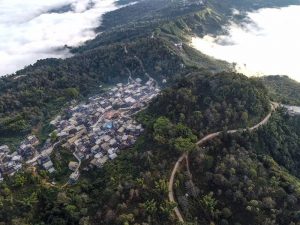
It is suitable to visit Lancang County all year round. Like many other cities in Yunnan, Lancang is a place where the seasons are like spring. There is no cold, no heat, warm and humid, especially suitable for human habitation, so you can go to Lancang at any time.
Recommended Tour
When you traveling Pu’er, Lancang County is a good place to be put on your list. It can be joined in whatever your Pu’er tour or Yunnan Tour.
11 Days Yunnan Ancient Tea-Horse Road Tour with Puer and XishuangBanna Tea Culture Exploration
14 Days Southwest Yunnan Tea Culture Tour from Xishuangbanna to Puer and Lincang
Travel Tips
1.There are many ethnic minorities living here, such as Lahu, Hani, Wa and Yi. Varied customs make it a colorful city. Eating habits, ceremonies, costumes and folk legends can all be a strong attraction for people who are visiting. In addition, the city is the hometown of the well known Puer Tea, and the local people have diversified ways of handling tea, such as bamboo tube tea, cold tea dish, earth-pot tea and baked tea; all of which you should try.
2.Enjoying a plateau monsoon climate at low latitude, the region is affected by the Indian Ocean and the Bay of Bengal. Therefore, the main features of its weather are mildness and humidity without strong winds.
3.Special Local Products: Puer Tea, bamboo shoot, edible fungi, purple rice, mango.

 7 Days GolfingTour
7 Days GolfingTour
 8 Days Group Tour
8 Days Group Tour
 8 Days Yunnan Tour
8 Days Yunnan Tour
 7 Days Shangri La Hiking
7 Days Shangri La Hiking
 11 Days Yunnan Tour
11 Days Yunnan Tour
 6 Days Yuanyang Terraces
6 Days Yuanyang Terraces
 11 Days Yunnan Tour
11 Days Yunnan Tour
 8 Days South Yunnan
8 Days South Yunnan
 7 Days Tea Tour
7 Days Tea Tour
 8 Days Muslim Tour
8 Days Muslim Tour
 12 Days Self-Driving
12 Days Self-Driving
 4 Days Haba Climbing
4 Days Haba Climbing
 Tiger Leaping Gorge
Tiger Leaping Gorge
 Stone Forest
Stone Forest
 Yunnan-Tibet
Yunnan-Tibet
 Hani Rice Terraces
Hani Rice Terraces
 Kunming
Kunming
 Lijiang
Lijiang
 Shangri-la
Shangri-la
 Dali
Dali
 XishuangBanna
XishuangBanna
 Honghe
Honghe
 Kunming
Kunming
 Lijiang
Lijiang
 Shangri-la
Shangri-la
 Yuanyang Rice Terraces
Yuanyang Rice Terraces
 Nujiang
Nujiang
 XishuangBanna
XishuangBanna
 Spring City Golf
Spring City Golf
 Snow Mountain Golf
Snow Mountain Golf
 Stone Mountain Golf
Stone Mountain Golf















